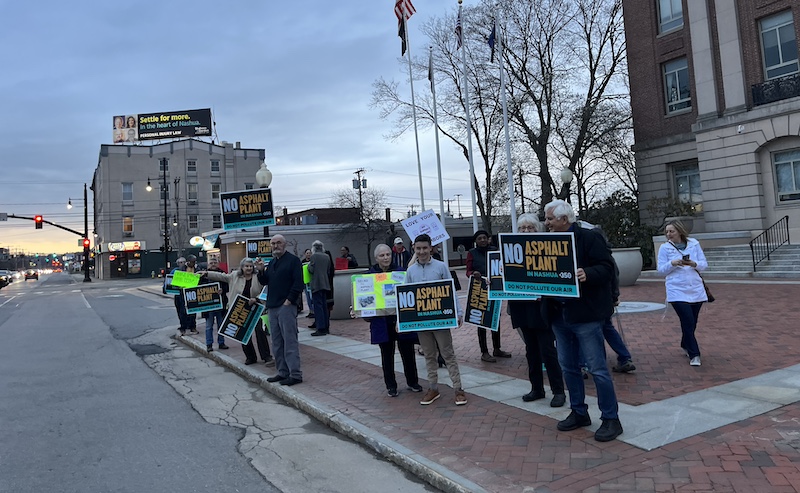
Nashua residents protest against the construction of a polluting asphalt plant in the East Hollis neighborhood. Photo: Heidi Trimarco
The East Hollis neighborhood of Nashua, New Hampshire, has some of the worst air quality in the city, according to measures used by the EPA. Polluted air has put residents at risk for health problems like cancer and asthma. So when the Newport Construction Company proposed building a new asphalt manufacturing plant in the neighborhood in 2022, residents were fed up.
East Hollis is an environmental justice community made up of low-income families, those with limited English proficiency, and people of color. It has historically been burdened by pollution and noise and the health problems they cause. Once again, this vulnerable community had been selected to host more polluting infrastructure, which would have compounded the toxic air residents already breathe each day.
Fortunately, the asphalt project was shelved. It failed to secure the local permits necessary for its construction. Residents, activists, and CLF fought hard to block the proposal and ultimately, the Nashua Planning Board rejected the plant. Nonetheless, the plant highlights a blind spot in New Hampshire state law, which, if left unresolved, will continue to expose communities like East Hollis to social and health inequities.
What Are “Cumulative Impacts” Laws?
Unlike other New England states, New Hampshire does not have laws designed to protect environmental justice communities like East Hollis. Such laws provide a much-needed framework for addressing historically disproportionate environmental harm. “Cumulative impacts” laws are one critical form of environmental justice legislation establishing requirements for state permitting agencies when considering whether to grant permits for polluting facilities.
These laws require government entities to evaluate a proposed new facility’s environmental and health effects in combination with a community’s existing exposure to environmental stressors.
Without a cumulative impacts law, state agencies are free to ignore the true, total impacts of a permitting decision. These effects may appear insignificant on their own. However, when combined with other pollution sources, they can result in the degradation of public health and the environment.
For example, Newport Construction needed approval from both the City of Nashua and the New Hampshire Department of Environmental Services. However, the environmental services agency was constrained under current state law from considering the total air and health impacts on a community already plagued by pollution. Rather, the agency could only consider the impacts of pollution emitted directly from the proposed facility without taking into account the existing pollution burdens facing the community.
This constrained regulatory review is particularly concerning for communities like East Hollis. The neighborhood ranks among the most polluted areas in the nation for all six of the air quality indices identified by the EPA as contributing to severe health impacts. Such impacts include an elevated risk of premature mortality, particularly from cardiovascular disease or lung and other types of cancer; negative reproductive effects and birth defects; and other health problems including, but not limited to, asthma attacks, reduction in lung function, hypertension, strokes, coughs, and headaches.
Absent consideration of this broader context in the state permitting process, Newport’s asphalt plant may have secured an air permit. And that would have worsened the neighborhood’s existing environmental stressors with increased truck traffic, noise, the release of fumes and nuisance odors, and exposure to harmful pollutants.
Cumulative Impacts Laws Gain Traction in the Northeast
In 2020, New Jersey became the first state in the country to successfully pass a “cumulative impacts” law. The law’s requirements are triggered when permit applicants seek to construct facilities in communities where 35% of households are low-income, 40% are minority, or 40% have limited English proficiency. In those circumstances, the state’s environmental protection agency requires permit applicants to submit a report, known as an “environmental justice impact statement,” which assesses the cumulative impacts of the proposed project on the surrounding community.
New York passed a similar law in 2023. In March of this year, the Massachusetts Department of Environmental Protection also announced new regulations requiring applicants to conduct cumulative impacts analyses for air quality permits near environmental justice populations.
Moving Towards Change
The East Hollis neighborhood and others like it need robust protection in New Hampshire. Passing a “cumulative impacts” law is one important way of securing that protection.
Conservation Law Foundation is actively working with stakeholders to explore cumulative impacts legislation in New Hampshire to better protect vulnerable communities.
State agencies need every tool in their toolboxes to protect environmental justice communities. Without change, communities that have historically borne the brunt of environmental degradation will continue to do so.
Ellie Buerk is a third-year law student at Case Western Reserve University School of Law. She interned at Conservation Law Foundation’s New Hampshire office in the summer of 2024.



